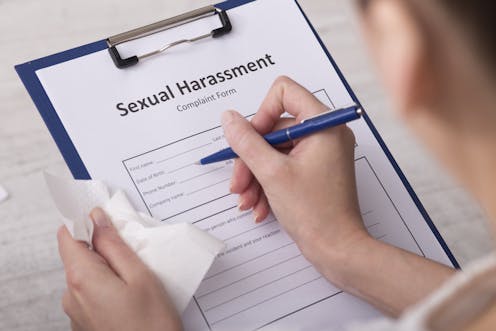Students less likely to report sexual harassment when the perpetrator is a professor
- Written by Stephen Aguilar, Assistant Professor of Education, University of Southern California

In 2017, Karen Kelsky, a consultant[1] for people looking for academic jobs, launched a survey[2] to capture people’s experiences of sexual harassment at colleges and universities. I took interest in this survey because it was widely reported[3] and sparked a lot of interest how sexual assault was affecting women on campus.
The crowdsourced survey – which began shortly after the #MeToo hashtag went viral[4] – drew more than 2,000 responses from people from throughout the United States and other places around the world. The respondents included people who indicated that they had been sexually harassed as undergraduates, graduate students or as faculty.
Even though the survey is based on self-selected respondents who chose to report on things that may have happened years ago, I still believe the survey approximates the occurrence of sexual harassment on campus.
As an educational psychologist[5] who focuses on how digital technologies[6] can be used to promote equity[7] and educational achievement, I wanted to know more. So I contacted Kelsky to ask if I could take a deeper look into the data. She agreed.
I began to systematically examine the data from Kelsky’s survey along with my Ph.D. student, Clare Baek[8]. Our study, published in March in PLOS ONE[9], found that students were 1.6 times more likely to not report their experiences when compared to faculty. We also found that students in the life and physical sciences – that is, subjects like biology and physics – were 1.7 times more likely to not report their experiences when compared to students in other disciplines.
Men represented 90% of the reported perpetrators of sexual harassment, according to this self-reported survey.
Respondents were asked if there were “institutional responses to the harassment.” After coding the data, we came up with six categories. On average, 34.3% of all respondents wrote that no action was taken, after they disclosed it, 36.9% did not report the incident, 9.3% reported that some action was taken by the institution, 6.6% reported that the action taken was unclear, 8% reported some sort of retaliation, and 5% did not fall into the above categories.
The decision to report or not report varied across disciplines, with roughly 50% of respondents in the physical sciences and engineering choosing to not report the incident. In contrast, only 18% of staff chose to not report the incident. Members of professional schools, humanities departments and social science departments were in the middle – 25% chose to not report the incident.
Keeping quiet
Kelsky’s survey also asked respondents about what happened and when, and what kind of impact the harassment had on their career, mental health and life choices.
We were interested in studying the emotional content of responses to those questions, so we analyzed responses with “natural language processing,” a data science technique that, among other things[10], shows the extent of positive, negative or neutral sentiment[11] within a response.
Respondents were asked to state what type of institution they were at, such as an elite or Ivy League school, or a small liberal arts college.
Our analysis found that when it came to mental health, the sentiment was more negative for student respondents to the survey, compared to faculty and staff respondents. Responses from students in the social sciences, who attended elite or Ivy League schools, were more negative than students who attended other types of schools, no matter what they were studying.
Consequences of telling
Our findings suggest that power matters when it comes to choosing not to report an incident. If the perpetrator was a faculty member, for example, respondents were 1.5 times more likely to not report the sexual harassment than when the perpetrator was not faculty. This shows why it is important for schools to examine how they go about taking reports of sexual harassment. It also shows the need for schools to establish clear policies and procedures on how to make a report of sexual harassment.
Among other things, schools should be taking a close look at whether there is something about the reporting process that is making students less likely to report. Are whistleblowers who come forth protected against retaliation? And, are there enough services in place, such as counseling, to help alleged victims after a report has been made?
[Insight, in your inbox each day. You can get it with The Conversation’s email newsletter[12].]
References
- ^ consultant (theprofessorisin.com)
- ^ survey (theprofessorisin.com)
- ^ widely reported (www.insidehighered.com)
- ^ #MeToo hashtag went viral (www.nytimes.com)
- ^ educational psychologist (rossier.usc.edu)
- ^ digital technologies (doi.org)
- ^ promote equity (doi.org)
- ^ Clare Baek (rossier.usc.edu)
- ^ PLOS ONE (www.doi.org)
- ^ among other things (dl.acm.org)
- ^ sentiment (doi.org)
- ^ You can get it with The Conversation’s email newsletter (theconversation.com)
Authors: Stephen Aguilar, Assistant Professor of Education, University of Southern California

